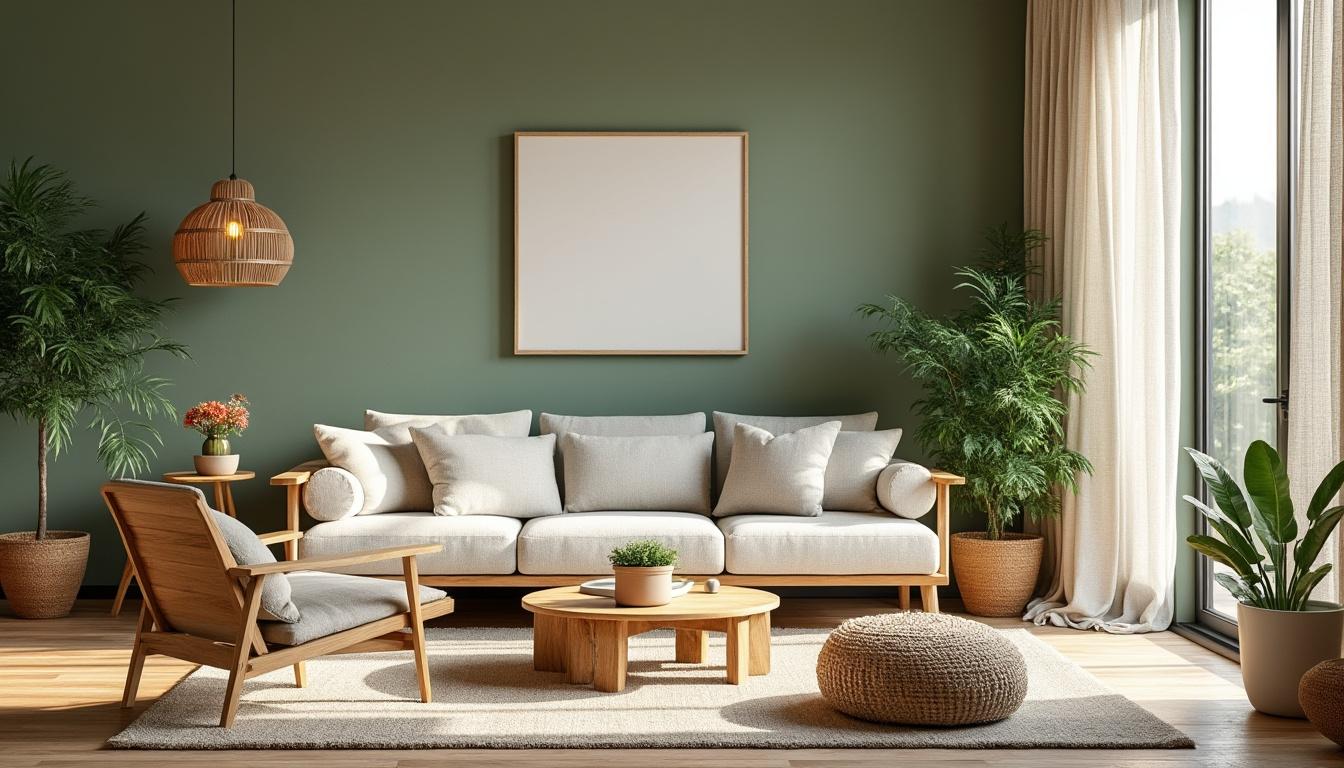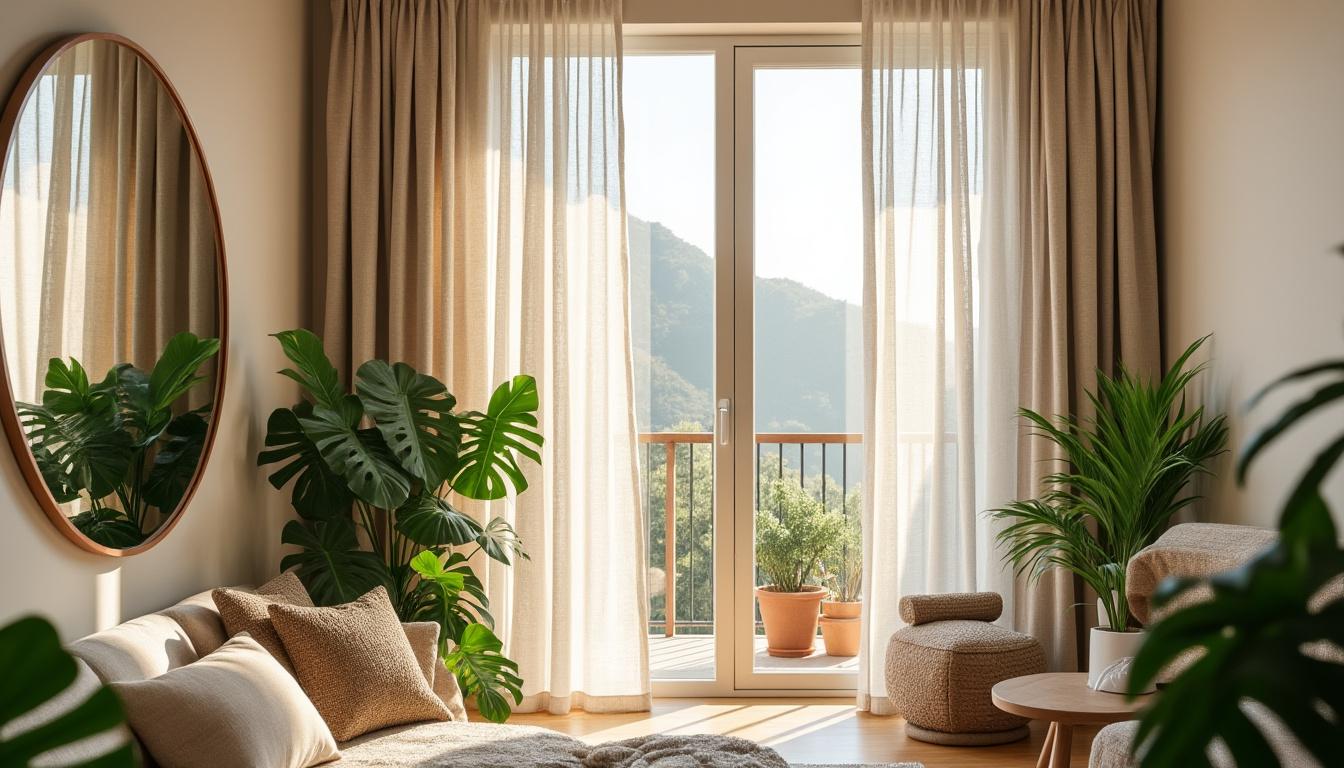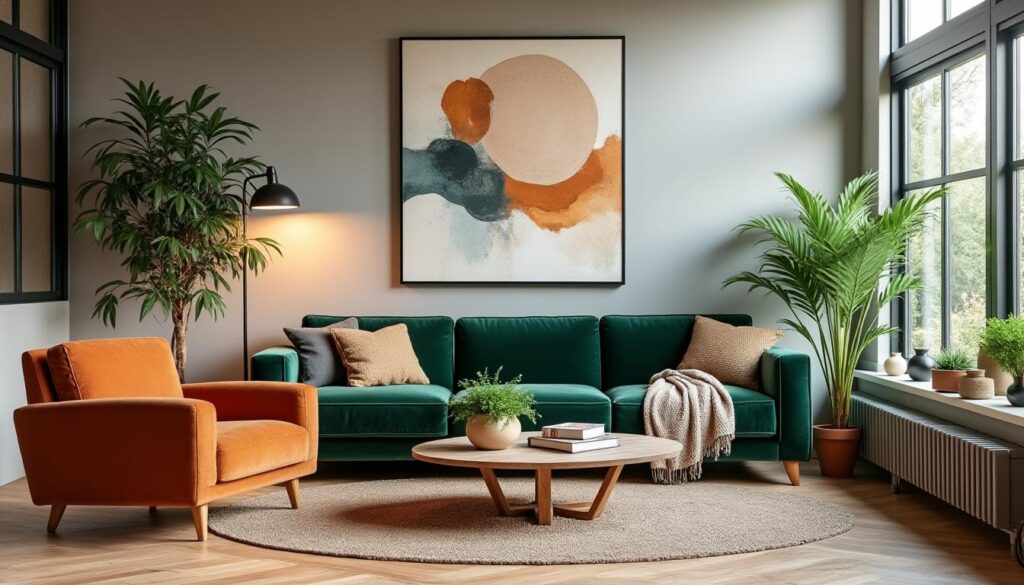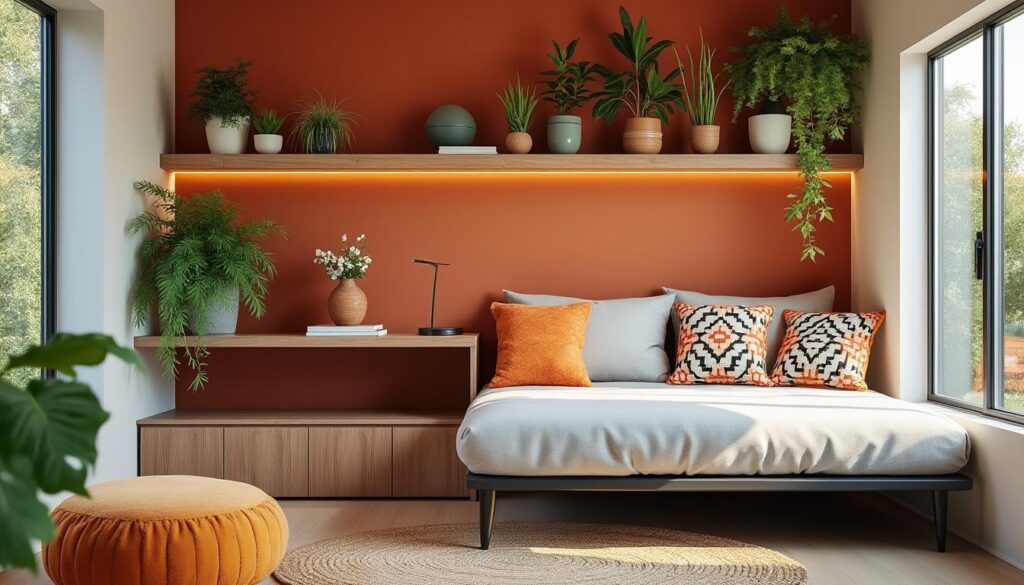Refreshing the décor can be simple, affordable, and sustainable when smart choices are made that enhance light, materials, and organization. The idea is to improve comfort and aesthetics without construction, waste, or unnecessary spending.
| Short on time? Here’s the gist: | Quick results ⚡ |
|---|---|
| ✅ Paint an accent wall | Transforms the living room in 1 day 🎯 |
| ✅ Upcycling: give new life to furniture/textiles | Unique style and less waste 🌱 |
| ✅ Plants + mirrors + lightweight curtains | More light, space, and well-being 🌞 |
| ✅ Beautiful organization with boxes and hooks | Practical home and less visual noise 🧩 |
| ✅ Removable wallpaper and vinyl | No construction, instant “wow” effect 🧲 |
Smart painting and textiles: immediate impact without construction
When the budget is tight, painting is the best ally. An accent wall changes the proportion of the space, enhances existing furniture, and defines the room’s palette. Soft tones remain strong in 2025, with pastels, earth tones, and organic greens conveying serenity and a connection to nature. Choosing low-VOC paints improves indoor air quality and reduces odors, especially useful in homes with children or pets.
Start by selecting the wall that receives the most light. In small rooms, opt for light colors to expand; in larger areas, a deeper shade creates coziness without feeling “heavy.” A 2.5 L can of matte acrylic paint costs on average €20–35, while rollers and masking tape cost around €8–12. In rented apartments, a neutral color makes returning a deposit easier, as it’s straightforward to repaint white.
An effective trick is to repeat the accent wall color in small elements: cushion covers, a throw over the sofa, the spine of books, or a ceramic vase. This subtle repetition harmonizes the overall look and creates coherence, even when mixing furniture from different eras. Lightweight curtains (such as linen or voile) filter light and visually “lift” the ceiling height.
How to choose the right palette without mistakes
Define a trio of colors: base (70%), complementary (20%), and accent (10%). The base will be for walls and larger textiles; the complementary lives in rugs and curtains; the accent appears in cushions, lamps, and frames. If you’re hesitant to be bold, first try samples on the wall and observe throughout the day. The same color changes with morning and afternoon light.
Ana and Rui, in a T2 in Oeiras, painted the wall behind the sofa in sage green, swapped the cushion covers for sandy tones, and added a mustard throw. In 24 hours and for less than €90, they achieved a calm and bright atmosphere. The secret? Repeating colors and using natural materials such as cotton and linen, which breathe better and last longer.
- 🎨 Choose matte paint for walls with imperfections: it disguises them better.
- 🧽 Wash the wall and use primer on dark colors for even coverage.
- 🖼️ Hang pictures aligned using painter’s tape as a visual guide.
- 🛋️ Refresh the sofa with cushion covers in different textures (velvet + linen).
- 🌿 Integrate a vase in a color that matches the accent color.
| Color choice 🎯 | Where to use 🏠 | Average time ⏱️ | Visual impact 🌟 |
|---|---|---|---|
| Sage green | Living room/bedroom | 1 day | Calm and freshness ✅ |
| Soft terracotta | Dining room wall | 1 day | Cozy and personality 🍂 |
| Light gray | Circulation | 1 day | Subtle elegance ✨ |
| Petrol blue | Office | 1–2 days | Focus and depth 🎯 |
Close the day with a color that respects the natural light of your home and complements simple textiles: the result is immediate and very durable.

Upcycling and transforming furniture and textiles to decorate on a budget
Giving new life to what already exists is quick, cost-effective, and sustainable. An exhausted piece of furniture can be reborn with water-based paint, new handles, or vinyl adhesive; old towels and t-shirts can be converted into durable rugs for the hallway and bathroom. In addition to saving money, textile waste is reduced, and a home with history is created.
The process is simple: lightly sand, clean dust, apply appropriate primer, and finish with 2 coats of paint. For a modern finish, try half of the furniture in natural wood and half painted, highlighting trim and legs. In rented kitchens, self-adhesive vinyl mimics wood, cement, or Portuguese tile, lasts well, and can be removed without damage.
In textiles, knitting strips (from towels or knits) creates rugs with grip and texture. On balconies, bench covers made from old curtains enhance comfort and resist the sun if you use UV-protected fabric. A family in Braga transformed three market crates into a modular shelf: they sanded, painted them off-white, and secured them with brackets; now they store books and plants in a very photogenic setup.
Weekend projects with great returns
If time is short, focus on what has the most impact for less cost: painting the side table, changing the handles on the dresser, covering cabinet doors with vinyl, updating lamps with new shades. On average, €40–80 is enough to transform an entire corner. Prefer low-emission glues and paints and recycle leftovers in recycling bins.
- 🪑 New handles change the “face” of the furniture in minutes.
- 🧵 Rags rug: cut strips, braid, sew circles, and join them.
- 🧲 Self-adhesive vinyl: measure, apply dry, use a spatula to expel bubbles.
- 🪵 Colorless wax on raw wood enhances the grain and protects without yellowing.
- ♻️ Use scraps for coasters, bookmarks, and small frames.
| Project ♻️ | Typical cost 💶 | Difficulty 🧰 | Time ⏳ | Result 🎉 |
|---|---|---|---|---|
| Paint coffee table | 25–40 € | Low | 1 afternoon | Looks new ✅ |
| Towel rug | 0–10 € | Medium | 1 weekend | Unique and washable 🧼 |
| Vinyl on cabinet | 15–30 €/m² | Low | 2–3 h | Updated and reversible 🔁 |
| Change handles | 10–25 € | Low | 30 min | Sophisticated detail ✨ |
The best part of upcycling is creating pieces with meaning: each intervention tells a story and saves resources, a simple gesture with real impact.
Plants, natural light, and mirrors: spaciousness and well-being in daily life
Plants bring life, regulate humidity, and create relaxing micro-landscapes. For beginners, resilient species such as pothos (Epipremnum), zamioculca, and syngonium tolerate low light and infrequent watering. Besides the aesthetic aspect, caring for greenery reduces stress and invites you to slow down. Combine with well-placed mirrors and lightweight curtains to multiply light.
To enhance natural lighting, move furniture away from windows and use wider rods, so curtains can open fully. If the ceiling height is low, install the rods closer to the ceiling: the window appears larger. Round mirrors create softness, and in narrow entries, a narrow vertical mirror elongates the space. Avoid reflecting messy areas; focus on landscapes, art, or the window itself.
In a studio in Coimbra, an oval mirror by the window doubled the afternoon light, while two plants on high shelves brought green without occupying passage space. In 2 hours and with €70, the environment seemed larger and more “breathable.” Warm light (2700–3000 K) at night helps transition to rest while maintaining coherence with natural materials.
How to care without complications
Simple rules work: finger in the soil before watering; if it’s moist, wait. Use pots with expanded clay to avoid excess water and protect furniture. Rotate pots monthly for even growth and clean leaves with a damp cloth. On balconies, protect from wind and strong summer sun.
- 🌿 Choose 3–5 easy species and repeat them for visual unity.
- 🪞 Position mirrors at a 90° angle to the window to reflect light, not glare.
- 🪟 Linen/voile curtains: privacy without blocking light.
- 💧 Water consistently, not “shockingly.”
- 🪴 Use pots with holes and saucers; roots will thank you.
| Species 🌱 | Light 💡 | Watering 🚿 | Tip ✅ |
|---|---|---|---|
| Pothos (Epipremnum) | Partial shade | Once a week | Hangs well on shelves 🪜 |
| Zamioculca | Low to medium | 2–3/week? No, once every 10–14 days | Ideal for forgetful people 😅 |
| Snake Plant | Varied | Once every 10–14 days | Resistant and graphic 🗿 |
| Syngonium | Medium | Once a week | Lush foliage 🌿 |
Want to deepen your choice of species and arrangements for indoors? Check out practical and accessible ideas for beginners.
Plants, light, and mirrors are the trio that improves the perception of space and emotional comfort, a small investment with a great daily return.

Beautiful organization that also decorates: boxes, shelves, and hooks
Organizing is decorating. When everything has a place, the home seems larger, maintenance becomes easy, and visual stress decreases. Boxes, baskets, shelves, and hooks create simple systems that work day-to-day. The “in sight, in hand” rule in kitchens and entrances prevents piles and delays. Materials like wood, wicker, and painted metal add texture and warm the composition.
Start by emptying one space at a time. Define zones: entry (keys, mail), living room (books, blankets), bedroom (bedding), bathroom (paper stock, cosmetics). Create “stations” with labeled boxes; labels make it easier for the whole family. On empty walls, narrow shelves (like a gallery) display books and pictures without threatening circulation.
High-quality adhesive hooks can hold backpacks and coats without leaving holes, perfect for renters. In kitchens, bars with S-hooks organize utensils and free up drawers. If you like DIY, sanded and varnished market crates can become rustic niches; combine them horizontally and vertically for a dynamic design.
Small actions that eliminate clutter
Set aside 15 daily minutes for a “visual reset”: cushions aligned, blankets folded, items returned to their place. Use a “house mail” basket for items without a designated place and empty it at the end of the day. A family in Porto reduced weekly tidying time by 25% by adopting boxes by category and hooks in the entry for the children’s backpacks.
- 📦 Transparent-lidded boxes: see contents, less frustration.
- 🧺 Wicker baskets: combine aesthetics and ventilation for textiles.
- 🪜 Low shelves for children’s books: children’s autonomy.
- 🧲 Adhesive hooks: no holes, great flexibility.
- 🏷️ Simple labeling: 1 word per box, easy and quick.
| Solution 🧩 | Best use 🏡 | Average cost 💶 | Benefit 💚 |
|---|---|---|---|
| Stackable boxes | Pantry/bedroom | 5–12 € | Maximizes vertical space 📈 |
| Adhesive hooks | Entry/kitchen | 4–10 € (pack) | Quick, reversible installation ⏱️ |
| “Gallery” shelf | Living room/hallway | 15–30 € | Easy rotation of art 🖼️ |
| Market crates | Living room/office | 0–8 € | Rustic and cheap style 🌿 |
For practical assembly ideas, follow tutorials focusing on small spaces and reversible solutions.
When organization is thought of as part of aesthetics, each object finds its place, and the home showcases its best.
Adhesive coverings and removable wallpaper: zero construction, maximum effect
If you want a style leap without “breaking everything,” invest in adhesive solutions. Removable wallpaper is perfect for rentals and offers geometric, natural patterns or textures like linen and cement. Likewise, vinyl for flooring and tiles renews kitchens and bathrooms in a few hours, with a clean and reversible installation.
Before applying, clean the surface with isopropyl alcohol and ensure it’s dry and smooth. Measure twice, cut once, and work in sections from top to bottom using a felt spatula to expel bubbles. On walls, align it plumb, not by the ceiling or baseboard (which may not be level). On floors, respect joints and use a pressure roller for better adherence.
In a rented T1 in Lisbon, the kitchen gained a new look with vinyl that mimics hydraulic tiles: 6 m² applied in 3 hours, with an investment of around €100–140. The tenant protected areas near the stove with a clear heat-resistant film, keeping it easy to clean. The same principle applies for headboards: an adhesive panel with texture creates focus without taking up space.
Choose the pattern and location strategically
Large patterns work best on small walls; small patterns tire less in extensive areas. Neutral textures help reconcile diverse furniture. If you’re apprehensive about taking risks, first apply it to a vertical strip of 60–80 cm and assess. In bathrooms, prefer vinyl specifically designed for moisture.
- 🧲 Removable paper: ideal for those who frequently change aesthetics.
- 🧼 Vinyl for tiles: easy to clean, perfect for backsplashes.
- 🧰 Felt spatula and sharp utility knife: must-have tools.
- 🧪 Test in a small area before advancing to the entire wall.
- ♻️ Save scraps for labels and small decorative details.
| Material 🧩 | Application 🔧 | Typical price 💶 | Removal 🔁 | Durability ⏳ |
|---|---|---|---|---|
| Removable wallpaper | Dry walls | 12–25 €/roll | Easy, no residue ✅ | 2–5 years |
| Vinyl for flooring | Floors/stairs | 10–20 €/m² | Reversible with moderate heat ♨️ | 2–4 years |
| Vinyl for tiles | Kitchens/bathrooms | 8–15 €/m² | Removes without damaging 🔧 | 2–3 years |
| Protective film | Backsplash/table | 6–12 €/m² | Removes in one piece 🧼 | 1–2 years |
Want to see the complete process and gain confidence before starting? Watch a step-by-step guide with installation tips on real surfaces.
Adhesive solutions are the “shortcut” to quick renovations without construction and regrets — just measure well and apply calmly.
Efficient and artisanal lighting: atmosphere, economy, and character
The right light transforms everything. A combination of layers — general, task, and ambient — adds depth, enhances textures, and creates comfort. Good quality LED bulbs consume less energy, last longer, and emit less heat. To make the home cozier, use warm light (2700–3000 K) in resting areas and neutral light (3500–4000 K) in work and kitchen.
Artisanal fixtures are cheap and charming DIY projects. A glass jar with textile cord and amber LED bulb becomes a pendant for a reading corner. Cotton rope lampshades softly filter light, and the structure can be made with an old hoop. On bedside tables, small lamps with dimmers are allies for sleep and economy.
Ideally, have switches by zones or smart plugs to control scenes: dinner, movie night, reading. In balconies and halls, motion sensors prevent lights from being left on unnecessarily. Remember that a color rendering index (CRI) above 90 offers color fidelity, essential for kitchens and creative spaces.
How to create layers of light without spending much
Distribute 3 points: ceiling (general), wall or desk (task) and floor/table lamp (ambient). Aim lights at walls or ceilings for soft reflection. If you’re making a fixture, check electrical certifications for components and use sockets suitable for the bulb’s wattage. In homes with children, protect cables and avoid placing exposed bulbs within reach.
- 💡 LEDs with 8–10 W easily replace 60 W incandescent bulbs.
- 🧶 Rope or fabric shades: easy to make, elegant result.
- 🎛️ Dimmer = one lamp, multiple atmospheres.
- 🔌 Programmable smart plugs reduce “phantom” consumption.
- 🛡️ Prioritize certified and insulated components.
| Zone 🌙 | Type of light 💡 | CCT (K) 🔆 | Practical tip 🧠 | Benefit ⚡ |
|---|---|---|---|---|
| Living room | General + ambient | 2700–3000 | Use a floor lamp with dimmer | Comfort and versatility ✅ |
| Kitchen | Focused task | 3500–4000 | LED strips under cabinets | Safe preparation 🍳 |
| Office | Task + general | 3500–4000 | Anti-glare directional light | Productive focus 🎯 |
| Bedroom | Soft ambient | 2700 | Opaque lampshade | Relaxation 😌 |
A well-designed light saves energy and creates atmosphere — it gives character to the space and enhances how each room is experienced.
Action to start today: choose a wall to paint, define a simple palette in three colors, and swap cushion covers to match. In 24 hours, the environment will already “breathe” differently.
{“@context”:”https://schema.org”,”@type”:”FAQPage”,”mainEntity”:[{“@type”:”Question”,”name”:”How much should I budget for a decorative renovation without construction?”,”acceptedAnswer”:{“@type”:”Answer”,”text”:”For one room, €150–300 is usually enough for paint, rollers, cushion covers, and one or two key elements (mirror, lamp, or removable wallpaper). Focus on what brings the greatest visual impact per euro invested: accent wall, textiles, and light.”}},{“@type”:”Question”,”name”:”What low-maintenance plants work best in apartments?”,”acceptedAnswer”:{“@type”:”Answer”,”text”:”Pothos, zamioculca, syngonium, and snake plant tolerate variations in light and infrequent watering. Observe your home’s brightness and adjust watering (between weekly and biweekly). Pots with holes and saucers help avoid excess water.”}},{“@type”:”Question”,”name”:”Does removable wallpaper damage the wall when removed?”,”acceptedAnswer”:{“@type”:”Answer”,”text”:”If the surface is clean, dry, and painted with washable paint, removal is simple and leaves no residue. Always test a small area first and pull slowly at a 45–60° angle to preserve the paint.”}},{“@type”:”Question”,”name”:”How to choose the color temperature of LED bulbs?”,”acceptedAnswer”:{“@type”:”Answer”,”text”:”Use 2700–3000 K for resting areas (living room and bedroom) and 3500–4000 K for tasks (kitchen, office). Look for CRI ≥90 for more accurate colors and less visual fatigue.”}},{“@type”:”Question”,”name”:”Is it possible to decorate with sustainability and low cost at the same time?”,”acceptedAnswer”:{“@type”:”Answer”,”text”:”Yes. Upcycling furniture, reused textiles, low VOC paints, and reversible adhesive solutions balance aesthetics, budget, and environmental impact. Planning and sustainable choices make all the difference.”}}]}How much should I budget for a decorative renovation without construction?
For one room, €150–300 is usually enough for paint, rollers, cushion covers, and one or two key elements (mirror, lamp, or removable wallpaper). Focus on what brings the greatest visual impact per euro invested: accent wall, textiles, and light.
What low-maintenance plants work best in apartments?
Pothos, zamioculca, syngonium, and snake plant tolerate variations in light and infrequent watering. Observe your home’s brightness and adjust watering (between weekly and biweekly). Pots with holes and saucers help avoid excess water.
Does removable wallpaper damage the wall when removed?
If the surface is clean, dry, and painted with washable paint, removal is simple and leaves no residue. Always test a small area first and pull slowly at a 45–60° angle to preserve the paint.
How to choose the color temperature of LED bulbs?
Use 2700–3000 K for resting areas (living room and bedroom) and 3500–4000 K for tasks (kitchen, office). Look for CRI ≥90 for more accurate colors and less visual fatigue.
Is it possible to decorate with sustainability and low cost at the same time?
Yes. Upcycling furniture, reused textiles, low VOC paints, and reversible adhesive solutions balance aesthetics, budget, and environmental impact. Planning and sustainable choices make all the difference.


